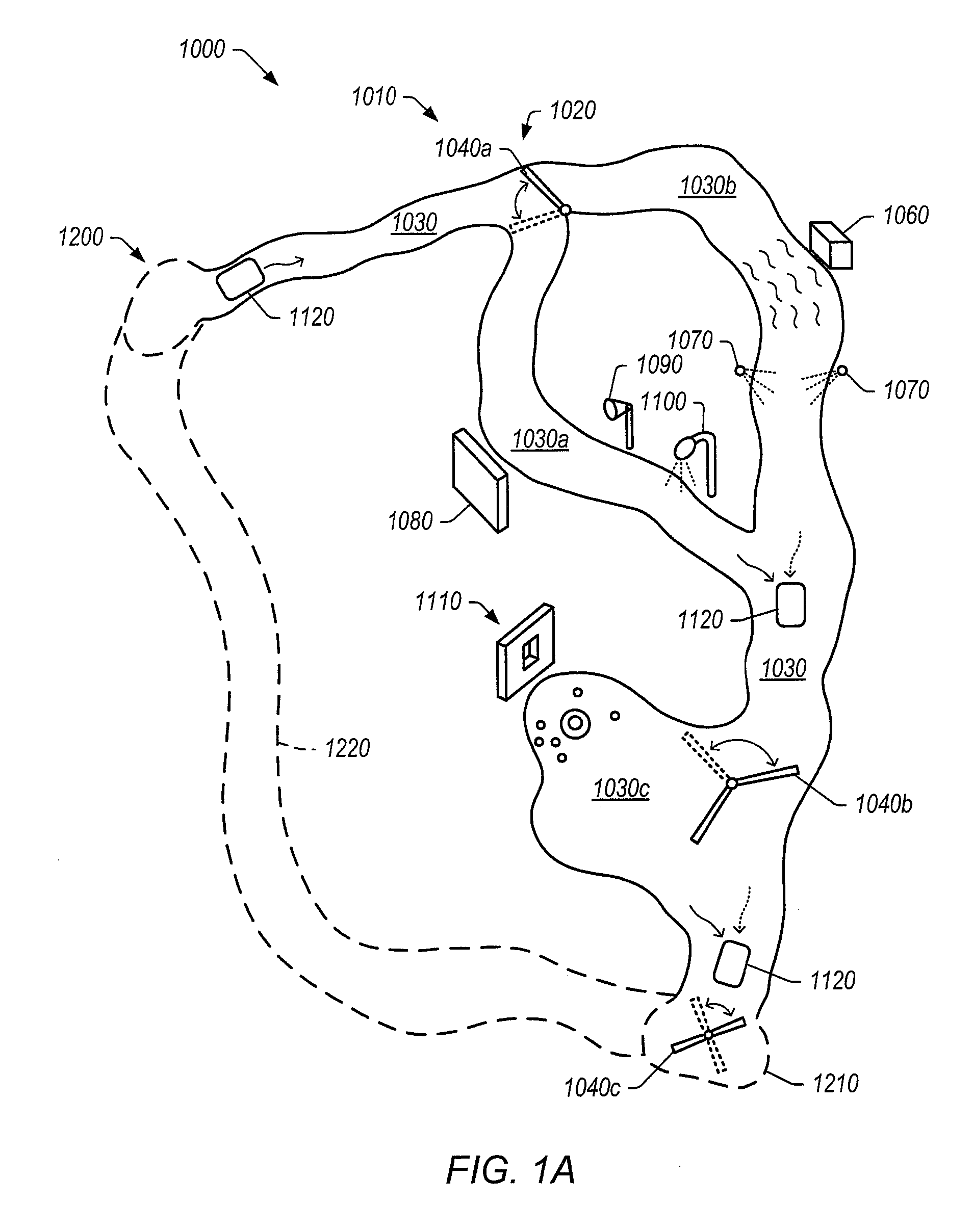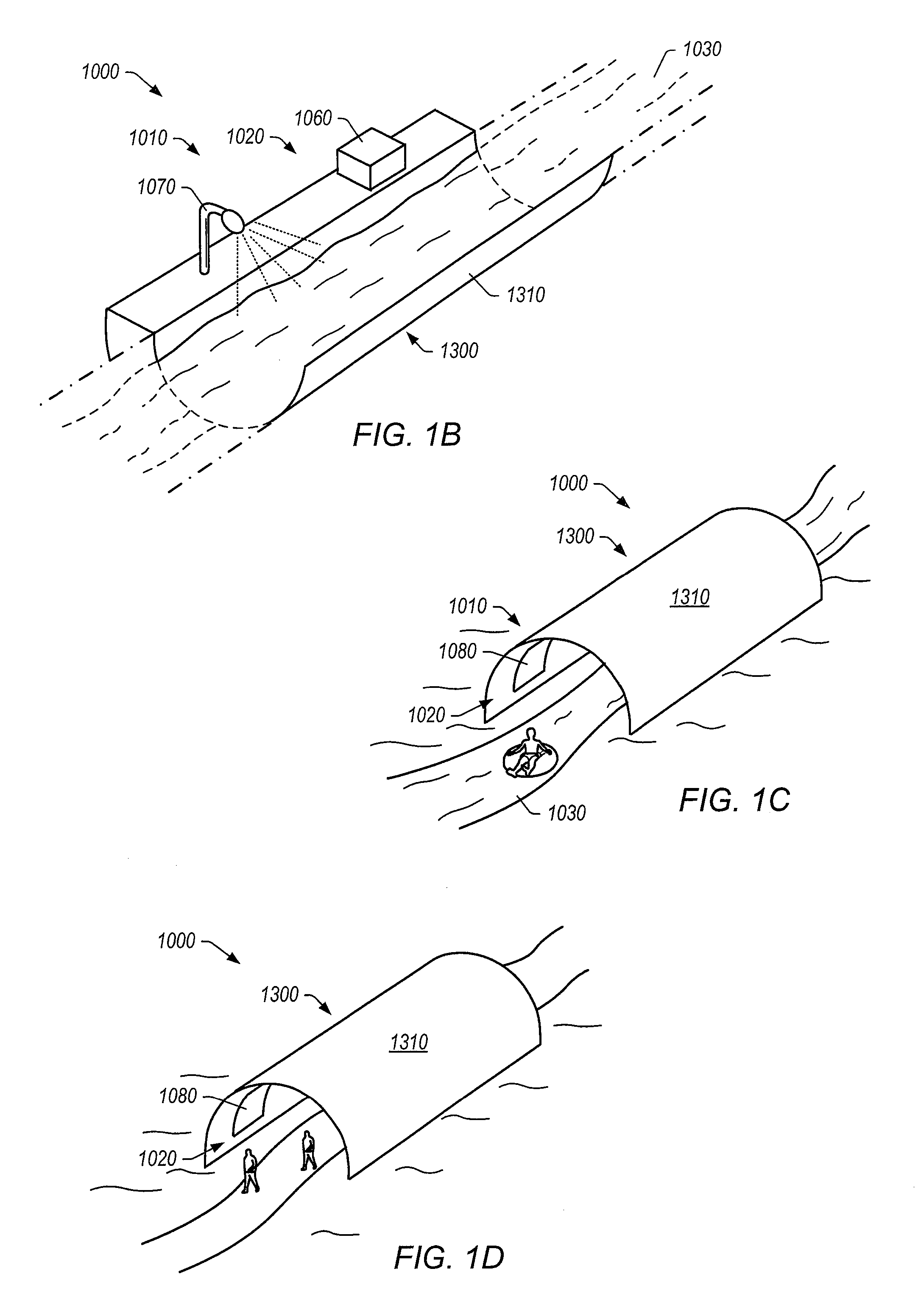[0015]For the reasons stated above and more, it is desirable to create dynamic waterpark attractions capable of enhancing the experience of the participant, as well as a natural and exciting water transportation system to transport participants between rides and through an amusement park. Such a system may enhance the experience of the participants, interconnect many of the presently diverse and stand-alone water park rides and / or accommodate disabled participants. The system could greatly reduce or eliminate the disadvantages stated above. In certain embodiments, dynamic waterpark attractions can be implemented to vary the operation of each attraction based on certain variables, such as whether or not the participant has already experienced one variation of the attraction, and can thus increase the number of experiences a participant can expect from a single ride. Further, in certain embodiments, dynamic attraction module systems include ride features and can be easily swapped with one another and / or rearranged to further vary and enhance participant experiences. The transportation system could also be used to transport guests from one end of a waterpark to the other, between rides and past rides and areas of high guest density, or between waterparks, or between guest facilities such as hotels, restaurants, and shopping centers. The transportation system would itself be a main attraction with exciting water and situational effects while seamlessly incorporating other specialized or traditional water rides and events. The system, although referred to herein as a transportation system, would be an entertaining and enjoyable part of the waterpark experience.
[0034]In some embodiments, a water transportation system is provided for solving many of the problems associated with waterparks as well as amusement parks in general. The system includes and uses elements of existing water ride technology as well as new elements that provide solutions to the problems that have prevented the implementation of this kind of system in the past. This water-based ride / transportation system combines the concepts of a ride providing transportation, sport, and entertainment. Unlike presently existing amusement park internal transportation rides, such as trains and monorails, the invention connects the various water amusement rides to form an integrated water park ride / transportation system that will allow guests to spend a far greater amount of their time at the park in the water (or on a floatation device in the water) than is presently possible. It will also allow guests to choose their destinations and ride experiences, and allows and encourages more guest activity during the ride.
[0035]In certain embodiments, a waterpark may include a continuous water ride. Continuous water rides may include a system of individual water rides connected together. The system may include two or more water rides connected together. Water rides may include downhill water slides, uphill water slides,
single tube slides, multiple participant tube slides, space bowls, sidewinders, interactive water slides, water rides with falling water, themed water slides, dark water rides, and accelerator sections in water slides. Connecting water rides may reduce long
queue lines normally associated with individual water rides. Connecting water rides may allow participants to remain in the water and / or a vehicle (e.g., a floatation device) during transportation from a first portion of the continuous water ride to a second portion of the continuous water ride.
[0037]Much of the increased time in the water is due to the
elimination of the necessity for guests to spend a large amount of time standing in queue lines waiting for rides, as the continuous water ride would be coupled with the ride so that the guest may transfer directly from the system to the ride without leaving the water. The continuous water ride also allows guests to easily access remote areas of the park normally underutilized, which will act to increase park capacity; it will allow guests to self-regulate guest densities at various facilities within the system by making it easier and more enjoyable to bypass a
high density area and travel to a
low density area. It will also allow disabled or physically disadvantaged guests to enjoy multiple and extended rides with one floatation device and one entry to and exit from the system. It greatly reduces the amount of required walking by wet guests and reduces the likelihood of slip-and-fall type injuries caused by running guests. It reduces reliance on multiple floatation devices for separate rides and reduces
wear and tear on the floatation devices by reducing or eliminating the need to drag them to and from individual rides, and allows park operators to provide guests with a single floatation device for use throughout the park.
[0038]All of the above devices may be equipped with controller mechanisms configured to be operated remotely and / or automatically. For large water transportation systems measuring miles in length, a programmable
logic control system may be used to allow park owners to operate the system effectively and cope with changing conditions in the system. During normal operating conditions, the
control system may coordinate various elements of the system to control
water flow. A pump shutdown will have ramifications both for water handling and guest handling throughout the system and may benefit from automated control systems to manage efficiently. The
control system may have
remote sensors to report problems and diagnostic programs designed to identify problems and
signal various pumps, gates, or other devices to deal with the problem as needed.
 Login to View More
Login to View More  Login to View More
Login to View More 


